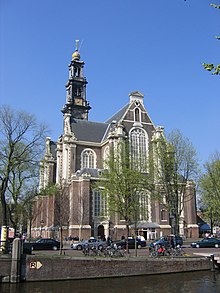Westerkerk (Amsterdam)
The Westerkerk belongs to the Protestant Church in Amsterdam and is located between Prinsengracht and Keizersgracht , on the edge of the Jordaan , the well-known residential area in the city center of Amsterdam. The Anne Frank House and the Homomonument are also nearby . The building is listed as a Rijksmonument .
architecture
The Westerkerk was designed by Hendrick de Keyser (1565-1621) in the Renaissance style and built in 1620-1631. After the death of the builder Hendrick de Keyser, who was buried in the Zuiderkerk , construction continued under the direction of his son Pieter de Keyser (1595–1676). On June 8, 1631, the church was given its destination. It has a length of 58 m and a width of 29 m.
West tower
The tower of the Westerkerk is more famous than the church itself. This is mainly due to the fact that the west tower is clearly visible from the surrounding area and is therefore often described (for example in Anne Frank's diary , who could hear the carillon from her hiding place) and sung about . He is nicknamed "Long Jan" or "The Old Wester".
The tower is 85 m high, making it the tallest church tower in Amsterdam. In the summer months you can climb it up to the first platform. The tower was renovated from February 2006 to May 2007 and can be visited again since then.
The steeple dates from 1638 and has bells by François Hemony . It concludes with Maximilian I's imperial crown . The Rudolf crown , the later Austrian imperial crown , was probably modeled on this crown. The Keizersgracht, with the Westerkerk on one side, was named after Maximilian I. In 1489, he allowed the city of Amsterdam to have its crown in its coat of arms, so that the steeple also shows part of the city's coat of arms.
Interior, equipment
Funerary monuments
Rembrandt van Rijn was buried in the northern part in 1669 . A memorial plaque erected in 1906 reminds of this. Rembrandt's son Titus and his lover Hendrickje Stoffels are also buried in the church.
Other painters buried in the church are Nicolaes Berchem , Gillis Claesz. de Hondecoeter and Melchior de Hondecoeter .
A commemorative plaque also commemorates the chemist and pharmacist Johann Rudolph Glauber from Franconia , after whom the Glauber's salt is named.
organ
The main organ goes back to an instrument that was built in 1686 by the organ builders Roelof Barentszoon Duyschot and Johannes Duyschot . This instrument had two manual works and a pedal work. In 1727, the organ builder Christian Vater , a student of Arp Schnitger , added a third manual , the upper part. Architecturally, the organ forms a unit with the church building and is provided with covers that were painted by Gerard de Lairesse (1640–1711).
In the 18th, 19th and 20th centuries, the organ was rebuilt several times, particularly with a view to the changing sound ideals. In the years 1989–1992 the instrument was extensively restored by the organ builder Flentrop Orgelbouw (Zaandam) and largely reconstructed - with a view to the condition of the organ in the years 1686 and 1727. Since only about 600 originals from this time are left Whistles were preserved, around 3,000 pipes had to be reconstructed. Which were maintained front pipes of main work, Rückpositiv and pedal mechanism of the 19th century, as did the Baar pipe from 1895 and was expanded disposition three reeds (Dulciaan 8 ', Fagot 16', Trumpet 4 '). In order to enable the interplay with other instruments and also the performance of organ literature from the 19th and 20th centuries, the pitch (historically: 460 Hz) was adjusted to 440 Hz. Since 1992 the instrument has a total of 41 stops on three manual works and pedal work.
|
|
|
|
||||||||||||||||||||||||||||||||||||||||||||||||||||||||||||||||||||||||||||||||||||||||||||||||||||||||||||||||||||||||||||||||||||||||||||||||||||||||||||||||||||||
- Coupling : I / II, II / I, III / I, I / P, II / P, III / P
- Tremulants : in addition to the tremulants of the individual works, a tremulant for the entire organ
Choir organ
The church has also had a choir organ since 1963 , which was built by Dirk Andries Flentrop and restored in 2001. The slider chest instrument has 12 stops on two manuals and a pedal. The actions are mechanical.
|
|
|
|||||||||||||||||||||||||||||||||||||||||||||||
- Coupling : II / I, I / P, II / P
Jos van der Kooy has been the organist of the Westerkerk since 1981 .
Web links
- Westerkerk website
- Westerkerk Amsterdam . In: iamsterdam.com
- Westerkerk (1620/31) Office for Monuments and Archeology (Dutch)
- Homepage cantor organist Jvd Kooy with information about the organ
Individual evidence
- ↑ Wim Alings: Kentekens in stad en land . Nefkens, Utrecht 1978, pp. 36-37.
- ↑ Information on the organ
- ↑ Information about the organ on the website of the builder company
Coordinates: 52 ° 22 '28.3 " N , 4 ° 53' 2.4" E













